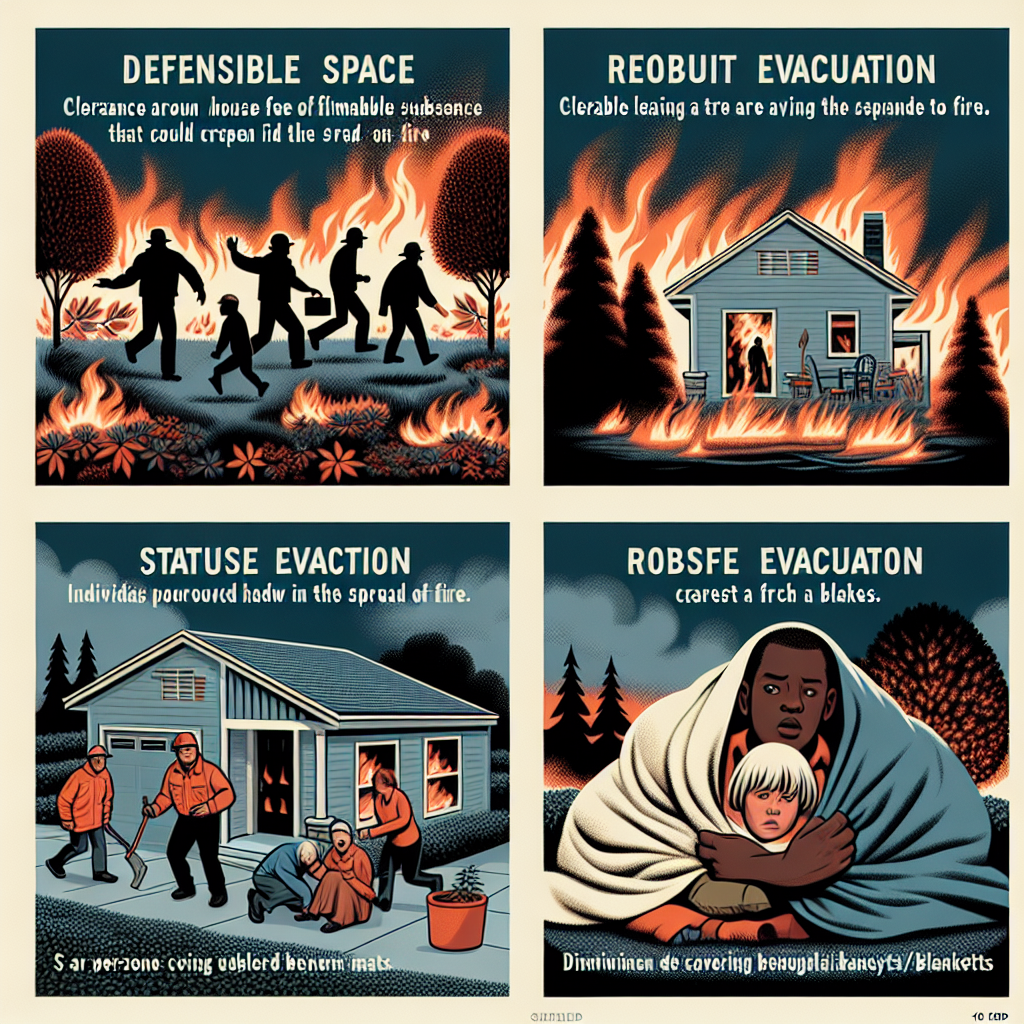In this article, you will find essential tips to keep you and your loved ones safe during a wildfire. Discover practical advice and precautions that will help you navigate the potential dangers of these unpredictable disasters. From creating defensible space around your home to staying informed about evacuation procedures, these wildfire safety tips will ensure you are well-prepared and can make informed decisions in the face of an emergency. Let’s dive in and equip ourselves with the knowledge to protect what matters most.

Creating Defensible Space
Clearing Vegetation
One of the most important steps in creating defensible space around your home is clearing vegetation. This means removing any dead or dry plants, bushes, and trees that could easily catch fire. Clearing vegetation also involves keeping your lawn well-maintained and regularly mowing it to minimize fuel for a fire. By removing potential fuel sources, you significantly reduce the risk of a wildfire spreading to your property.
Maintaining a Safe Distance
To create an effective defensible space, it is vital to maintain a safe distance between structures and nearby vegetation. This means keeping shrubs, trees, and other plants at least 30 feet away from your home. To increase your home’s protection, consider extending the clearance zone to 100 feet if you live in an area prone to wildfires. This buffer zone acts as a barrier, reducing the chances of flames reaching your property.
Removing Combustible Debris
In addition to clearing vegetation, it is crucial to remove any combustible debris from your surroundings. This includes fallen leaves, twigs, and other debris that can accumulate on your property. Regularly clean up any dead plant material and dispose of it properly. By removing combustible debris, you eliminate potential fuel sources that can ignite and intensify a wildfire. Regular maintenance and cleaning go a long way in protecting your home from the threat of wildfires.
Home Safety Measures
Regularly Cleaning Roofs and Gutters
Keeping your roofs and gutters clean is an essential home safety measure to prevent wildfires from spreading. Clearing debris such as leaves and pine needles helps eliminate potential fuel sources on your roof. Regular maintenance and inspections ensure that your roof is in good condition and less prone to fire risks. Additionally, regularly cleaning your gutters prevents the buildup of dry leaves and other flammable material that could ignite in case of a nearby wildfire.
Covering Vents and Openings
Another important home safety measure is covering vents and openings throughout your property. Embers from a wildfire can travel long distances and easily enter your home through cracks, vents, and other openings. Installing mesh screens or covers over vents and sealing gaps around windows and doors can help prevent embers from entering and starting secondary fires inside your home. By properly sealing these openings, you create a barrier against embers and enhance the fire resistance of your property.
Using Fire-Resistant Materials
When it comes to building or renovating your home, using fire-resistant materials is essential to minimize the risk of fire damage. Opt for materials such as brick, stone, concrete, and metal, as they are less likely to ignite during a wildfire. Avoid flammable materials like untreated wood or vinyl sidings, which can easily catch fire and lead to the rapid spread of flames. By choosing fire-resistant materials, you enhance the overall safety and resilience of your home against wildfires.
Installing Spark Arresters
Spark arresters are devices designed to prevent sparks and embers from escaping through chimneys or flues. Installing spark arresters on your chimney and any other venting systems connected to wood-burning appliances is crucial. These devices help minimize the risk of releasing embers into the air, where they can ignite nearby vegetation or structures. Regularly inspect and maintain spark arresters to ensure they are in proper working condition and provide effective protection against airborne sparks.
Having an Emergency Water Supply
Preparing an emergency water supply is an important safety measure to protect your home and surrounding areas from wildfires. Ensure you have an adequate water source, such as a well-maintained swimming pool or a water tank, that can be used for firefighting purposes. Make sure you have proper hoses and sprinklers readily available to quickly douse the area if a wildfire approaches. Having an emergency water supply can make a significant difference in your ability to defend your property and prevent the spread of fire.
Fireproofing Your Property
Trimming Trees and Shrubs
Regularly trimming trees and shrubs is an essential step in fireproofing your property. Keep tree branches at least 10 feet away from chimneys and other structures to prevent direct contact with potential fire sources. Prune any dead or overhanging branches that could easily catch fire. Additionally, maintain a clearance of at least 15 feet between trees and shrubs. By doing so, you reduce the risk of flames spreading from vegetation to nearby structures.
Creating a Firebreak
Creating a firebreak around your property acts as a defensive barrier against the spread of wildfires. A firebreak is an area with little to no vegetation that prevents fire from easily crossing over to your property. This can be achieved by removing all tall grass, brush, and dead plants within a designated distance around your home. Creating a clear space of at least 30 feet can help slow down the momentum of a wildfire and prevent it from reaching your property.
Using Mulch Alternatives
Mulch can be a fire hazard, particularly when placed near structures. Consider using mulch alternatives that are non-combustible or have a higher resistance to ignition. Materials such as gravel, rocks, or non-flammable shredded rubber can replace traditional wood mulch. If using wood-based mulch, ensure it is placed at least five feet away from structures, and keep it at a minimal depth to minimize the risk of igniting during a wildfire.
Avoiding Woodpiles Near Structures
If you have woodpiles for firewood, it is essential to store them safely away from your home and any other structures. Ideally, woodpiles should be located at least 30 feet from buildings and elevated above the ground to reduce the risk of embers igniting them. Ensure that woodpiles are neatly stacked and separate individual logs to create airflow. Properly managing and storing firewood helps prevent the spread of fire from woodpiles to structures during a wildfire.
Developing an Emergency Plan
Familiarizing with Local Authorities’ Instructions
To effectively respond to a wildfire, familiarize yourself with local authorities’ instructions and evacuation protocols. Stay informed about the emergency procedures specific to your area and know the designated evacuation routes. Understand the signals used for evacuation warnings and be prepared to act quickly when advised to do so. By being informed and familiar with local procedures, you can protect yourself and your loved ones in the event of a wildfire.
Creating an Emergency Kit
Having an emergency kit ready is essential for any disaster situation, including wildfires. Your emergency kit should include essentials such as food, water, medications, a first aid kit, flashlights, batteries, and a portable battery-powered radio. Additionally, include important documents such as identification papers, insurance policies, and contact information for local authorities and emergency services. Having an organized and easily accessible emergency kit ensures you are well-prepared and can quickly respond to any urgent situation.
Establishing a Communication Plan
During a wildfire, communication is crucial. Establish a communication plan with your family and loved ones to ensure everyone knows how to stay in contact and where to meet if evacuation becomes necessary. Designate a person outside the affected area as a central point of contact and share their contact information with everyone in your household. This way, even if cell phone towers or internet services are disrupted, you have a designated person to relay and receive important information.
Establishing Evacuation Routes
Knowing multiple evacuation routes is vital in case one route becomes inaccessible due to fire activity. Identify primary and alternative evacuation routes from your home and familiarize yourself with them. Consider the terrain, road conditions, and any potential obstacles that may arise during an evacuation. By having multiple evacuation routes planned out, you increase your chances of safely escaping a wildfire and reaching a designated evacuation center or safe location.
Identifying Safe Meeting Locations
In the event of a wildfire, you may need to evacuate your home and separate from your family temporarily. Identify safe meeting locations where you can gather if evacuation becomes necessary. Choose easily accessible locations away from the immediate danger zone, such as a neighbor’s house, a community center, or a designated meeting point identified by local authorities. Communicate these locations with your family members and ensure everyone knows where to reunite if separated.

Preparing Your Home
Ensuring Working Smoke Alarms
One of the simplest yet most lifesaving measures you can take to protect your home is ensuring the presence of working smoke alarms. Install smoke alarms on every level of your home, including inside bedrooms and outside sleeping areas. Test smoke alarms monthly and replace batteries annually to ensure they are functioning properly. Smoke alarms can provide you with early warnings, giving you more time to evacuate safely in the event of a wildfire or any other fire emergency.
Keeping Fire Extinguishers Handy
Having readily accessible fire extinguishers in your home is essential for quickly responding to small fires before they escalate. Place fire extinguishers in easily accessible locations, such as the kitchen, garage, or near fire-prone areas. Ensure you have the appropriate type of fire extinguisher for the specific classes of fire that may occur, such as Class A (ordinary combustibles) or Class B (flammable liquids). Regularly inspect and recharge fire extinguishers to ensure they remain fully functional.
Organizing Important Documents
Organizing and keeping important documents in a fireproof and waterproof container is crucial for swift recovery after a wildfire. Store copies of identification papers, insurance policies, medical records, and other essential documents in a secure location that is easy to grab in case of an evacuation. Additionally, consider storing digital copies of important documents in password-protected cloud storage or an external hard drive. Having backups ensures that even if physical documents are lost or damaged, you can still access critical information.
Backing Up Digital Data
In our digital era, protecting digital data is equally important as safeguarding physical documents. Regularly back up your digital files, including important photos, videos, and documents, to an external hard drive or cloud storage. Store these backups in a secure off-site location to ensure their safety in the event of a wildfire. By backing up your data, you protect cherished memories and critical information from potential loss or damage.
Protecting Sensitive Valuables
Take appropriate measures to protect sensitive valuables from the threat of wildfires. Safeguard items such as jewelry, family heirlooms, and important keepsakes by storing them in a fireproof safe or safety deposit box. Keep these items separate from your everyday possessions to ensure their protection in case of a fire. By taking proactive steps to secure your sensitive valuables, you provide yourself with peace of mind and can focus on ensuring the safety of your loved ones during a wildfire.
During a Wildfire
Monitoring Local News and Emergency Alerts
During a wildfire, it is crucial to stay informed about the latest developments and instructions from local authorities. Monitor local news and radio stations for updates on the fire’s behavior, evacuation orders, and emergency instructions. Sign up for emergency alert systems in your area and ensure your cell phone is set to receive wildfire-related notifications. By staying informed, you can make informed decisions to protect your safety and the safety of your loved ones.
Evacuating if Instructed to do so
If local authorities issue an evacuation order, it is imperative to take it seriously and evacuate immediately. Follow the designated evacuation routes and directions provided by emergency personnel. Do not delay or wait until the last minute to leave. Evacuating promptly allows emergency responders to focus on firefighting efforts and helps ensure your safety. Remember, property and possessions can be replaced, but your life cannot.
Closing Windows and Doors
If you are in an evacuation zone but have not yet been instructed to evacuate, take steps to prepare your home for potential ember showers. Close all windows and doors to prevent embers from entering your home. Shutting windows and doors minimizes the risk of embers igniting flammable materials inside your house. Be sure to also close interior doors to prevent the rapid spread of fire should one occur.
Turning Off Gas and Utilities
Before evacuating, turn off the gas supply to your home at the meter or propane tank. This reduces the risk of gas leaks or explosions in case of a wildfire reaching your property. Additionally, shut off other utilities such as electricity and water if time permits and it can be done safely. Remember, consult local authorities or utility companies for guidance if unsure about how to safely shut off utilities.
Wearing Protective Clothing
If you find yourself in a situation where evacuation is not possible and you need to seek shelter from a wildfire, wearing protective clothing can significantly enhance your chances of survival. Wear long-sleeved shirts, long pants, and sturdy shoes or boots. Choose natural fibers like cotton or wool, which are less likely to melt onto your skin. Cover your head with a hat or bandana and use goggles or a mask to protect your eyes and respiratory system from smoke and ashes.

Safe Outdoor Practices
Properly Extinguishing Campfires
When camping or enjoying outdoor activities, it is vital to properly extinguish campfires to prevent wildfires. Allow the firewood to burn down to ashes, then pour water over the fire to douse it completely. Stir the ashes with a stick or shovel to ensure all embers are extinguished. Repeat the process until the fire is cold to the touch. Remember, even the smallest ember can reignite, so never leave a campfire unattended or assume it is out without thoroughly extinguishing it.
Using Barbecues and Stoves in Designated Areas
If you plan to use barbecues or stoves in outdoor areas, ensure you do so in designated areas where it is safe to do so. Follow local regulations and guidelines for outdoor cooking and never use grills or stoves near combustible materials, dry vegetation, or under tree canopies. Keep a safe distance from structures and always have a fire extinguisher or water source nearby. By using cooking appliances responsibly, you reduce the risk of unintentionally igniting a wildfire.
Avoiding Outdoor Burning
To prevent wildfires, it is essential to avoid outdoor burning during periods of high fire danger. Pay attention to local fire restrictions and laws regarding burning, particularly during dry and windy seasons. Dispose of yard waste and other flammable materials through approved methods, such as curbside pickup or designated composting sites. Avoid burning debris, as even controlled burns can quickly get out of hand and pose a serious risk to surrounding areas.
Disposing of Cigarette Butts Safely
If you or those around you smoke, it is crucial to dispose of cigarette butts safely and responsibly. Never throw cigarette butts out of a vehicle or discard them in dry or grassy areas. Use an ashtray or a designated cigarette disposal container to fully extinguish and collect cigarette butts. Empty ashtrays into proper waste receptacles, ensuring there are no remaining embers that could ignite vegetation. By taking these simple steps, you reduce the risk of a discarded cigarette starting a wildfire.
Using Equipment Safely in Outdoor Spaces
When operating machinery or equipment in outdoor spaces, take precautions to minimize the risk of starting a wildfire. Avoid using power tools, lawnmowers, or chainsaws during hot and dry conditions, as sparks from these machines can easily ignite dry vegetation. Ensure all equipment is well-maintained and free from any fuel or oil leaks that could potentially cause a fire. Always have a fire extinguisher or water source nearby when using equipment, and be mindful of the conditions and potential fire hazards in your surroundings.
Protecting Pets and Livestock
Having a Ready-To-Go Pet Emergency Kit
Just as you prepare an emergency kit for yourself, it is important to have a ready-to-go emergency kit for your pets or livestock. Include essentials such as food, water, medications, leashes, collars, identification tags, and any necessary documents. Keep a pet carrier or crate readily available for easy transport. Ensure that your pets are up-to-date on vaccinations and have proper identification, such as microchipping, in case they become separated from you during a wildfire.
Keeping Pets Indoors or in Enclosed Areas
During a wildfire, it is safest to keep your pets indoors or in enclosed areas to protect them from smoke, flying embers, and potential dangers. Close all windows and doors to prevent embers from entering your home or enclosure. If you have outdoor pets or livestock, consider moving them to safer locations away from areas at high risk of spreading wildfires. Always prioritize the safety and well-being of your animals during wildfire events.
Evacuating Animals if Necessary
In case of an evacuation order, make plans to evacuate your pets or livestock, as well. Identify shelters, boarding facilities, or friends and family who can accommodate your animals if you need to leave your home. Ensure that your emergency kit includes enough food, water, and supplies for your animals. If evacuating large animals or livestock, have trailers or transportation arrangements prepared in advance. By planning ahead, you can ensure the safety and welfare of your beloved pets during a wildfire.
Designating Multiple Routes for Animals
When evacuating animals, it is essential to have multiple designated routes to ensure safe and efficient transportation. Identify alternative routes in case primary routes become congested or inaccessible due to fire activity. Be aware of any height or weight restrictions along the evacuation routes to ensure your transportation is suitable for large animals or livestock. Proper planning and identification of multiple routes enable smoother evacuations and the well-being of your animals.
Ensuring Proper Identification and Microchipping
Proper identification is vital for reuniting pets with their owners following a wildfire or any other emergency situation. Ensure your pets have up-to-date ID tags with your contact information. Additionally, consider microchipping your pets, as it provides a permanent and reliable form of identification. Keep your contact information updated with the microchip registration company. Proper identification significantly increases the chances of being reunited with your pets if they become lost or separated during a wildfire event.

Supporting Firefighters and First Responders
Obeying Evacuation Orders
One of the best ways to support firefighters and first responders during a wildfire is to obey evacuation orders issued by local authorities. Evacuating promptly and efficiently helps firefighters focus their efforts on combating the fire, rather than needing to rescue individuals who have chosen to stay behind. By heeding evacuation orders, you not only protect your own safety but also contribute to a safer firefighting environment for emergency personnel.
Staying Informed to Avoid Interfering with Operations
Stay informed about the ongoing firefighting and emergency operations in your area to avoid interfering with their efforts. Respect road closures, access restrictions, and any other instructions put in place by authorities and emergency personnel. Avoid unnecessary travel through fire-affected areas or areas of ongoing operations, as this can impede firefighting efforts and pose risks to your safety and the safety of emergency responders.
Donating to Fire Relief Efforts
Supporting fire relief efforts is another meaningful way to show your appreciation and help those affected by wildfires. Many organizations and nonprofits work tirelessly to provide assistance to individuals and communities impacted by wildfires. Consider making a monetary donation or contributing needed supplies to these organizations. Your support can make a significant difference in providing relief, recovery, and support to those affected by wildfires and the brave firefighters working on the frontline.
Offering Assistance to Displaced Residents
In the aftermath of a wildfire, many individuals and families may be displaced or in need of immediate assistance. Offer your support by reaching out to local charities or community organizations to volunteer your time or resources. Help distribute necessary supplies, provide temporary housing, or lend a helping hand in any way possible. The collective efforts of the community can make the recovery process smoother and provide much-needed support to those in need.
Showing Appreciation and Respect
Take the time to recognize and appreciate the bravery and dedication of firefighters and first responders who put their lives on the line to protect communities from wildfires. Show your gratitude and respect by thanking them for their service and expressing your appreciation for their hard work. Small gestures, such as sending thank-you notes or participating in community events honoring their efforts, can go a long way in uplifting their spirits and acknowledging their invaluable contributions.
Post-Wildfire Recovery
Waiting for Official Clearance to Return
After a wildfire, it is essential to wait for official clearance from local authorities before returning to your home or property. Wildfires can leave behind hidden dangers such as unstable structures, ash pits, and smoldering embers. Local authorities will assess the safety of the area and provide instructions on when it is safe to return. Respecting these guidelines ensures your safety and allows emergency personnel to conduct necessary assessments and continue their work without interference.
Assessing Home and Property for Damage
Once authorities have given the clearance to return, carefully assess your home and property for any damage caused by the wildfire. Look for structural damage, compromised utilities, or potential hazards that may have been created during the fire. Take photographs and document the extent of the damage for insurance and recovery purposes. If you suspect damage to utilities, contact the proper authorities or professionals to conduct inspections and necessary repairs before resuming normal activities.
Contacting Insurance Companies
After a wildfire, promptly contact your insurance company to report the damage and initiate the claims process. Provide them with detailed information and documentation of the damage to your home, property, and belongings. Work closely with your insurance company to understand the coverage and claims process, and follow any necessary steps or requirements to ensure a smooth and efficient claims experience. Document all communication and keep records of any expenses incurred during the recovery process.
Seeking Professional Help for Restoration
Depending on the extent of the damage, you may need to seek professional assistance for the restoration of your home and property. Engage licensed contractors, restoration specialists, or other professionals experienced in post-wildfire recovery. They will have the expertise and equipment to safely address structural repairs, cleaning, and remediation of fire and smoke damage. Ensure that the professionals you hire are reputable, insured, and knowledgeable in handling wildfire-related restoration.
Taking Care of One’s Mental Health
Going through a wildfire and its aftermath can be a traumatic experience, impacting your mental health and well-being. It is crucial to prioritize your mental health and seek support if needed. Reach out to support groups, counseling services, or mental health professionals specializing in post-disaster recovery. Participate in community events or programs that promote healing and resilience. Take time to engage in self-care activities that bring you comfort and help in navigating the emotional challenges of recovering from a wildfire.
In conclusion, creating defensible space, implementing home safety measures, fireproofing your property, developing an emergency plan, and taking necessary precautions during a wildfire all contribute to protecting yourself, loved ones, and property from the risks associated with wildfires. By following these comprehensive wildfire safety tips, you can mitigate the potential damage and ensure your safety in the face of this common and dangerous natural disaster. Remember, wildfires can be unpredictable, and it is vital to stay informed, be prepared, and prioritize safety at all times.






